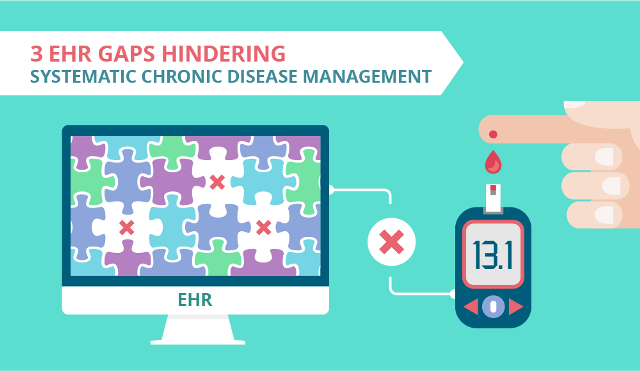
The following is a guest blog post by Andrei Khomushka.
An EHR typically contains multiple highlights of patients’ health, including observations, lab results, diagnoses and treatment plans. However, this data might be insufficient for systematic chronic care management, and there are 3 key reasons for that.
1. Interrupted care setting
Most EHRs are built around the idea that patients control their conditions to the extent that they can arrange timely appointments with their doctors should disturbing symptoms arise. However, the no-shows rate is still high (up to 55%, according to Family Medicine, 2013), and chronic patients often tend to overlook and mistreat symptoms. Leading to occasional appointments in acute situations. This breaks patient data and thus care delivery. So, EHRs can’t show the real picture of a disease progression.
Only continuous care and health tracking can help prevent, or at least detect early complications and exacerbations. As EHRs simply don’t have the tracking functionality, providers need additional solutions bound to their EHRs. For example, mobile patient apps connect individuals and caregivers, allowing the former to sync medical devices and continuously share their health data with doctors, thus ensuring remote monitoring of health status. Then, this information is automatically analyzed and aligned with the EHR so it’s always up-to-date.
2. Lack of patient engagement
As individuals can’t access EHRs directly, they don’t provide any patient engagement elements. Patients can only interact with the EHR data (to some extent) by visiting the patient portal. Here is your chance to engage them. With the standard functionality, such as appointment scheduling, e-billing, lab results checking, portals allow setting goals, sharing achievements across social media, exploring interactive learning materials and more.
However, systematic chronic care is more effective when a technology is proactive and connected to a patient’s daily life (patient portals can’t beat mobile patient apps here). This way, when multiple personal encouragements, guidelines and notifications are already in your pocket, it’s easier to control a chronic condition.
3. Patient-generated data missing
Most EHRs can’t collect and store patient-generated information such as physical activity, nutrition, daily subjective and objective. To benefit from daily updates of patients’ health statuses, we suggest implementing a separate solution integrated with the EHR. This will automatically process and analyze data to identify condition changes that require a physician’s attention. Then, the solution will notify both the patient and the health specialist about the disturbing patterns and suggest scheduling an appointment or test.
Afterword: Reducing the gaps
Overcoming these limitations is essential for a systematic care of chronic patients in the comfort of their homes. However, a thorough rebuild of an EHR is not realistic. Instead of investing substantial time and budget in making the EHR something it is not supposed to be, we recommend creating a holistic solution based on a chronic disease management system (CDMS), which will be connected to the mobile patient application and the EHR. You can find more about CDMS and its benefits in our recent chronic disease management entry.













